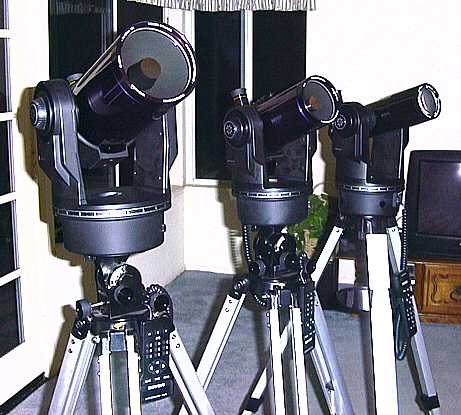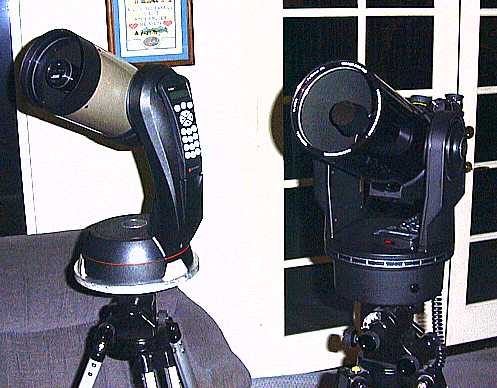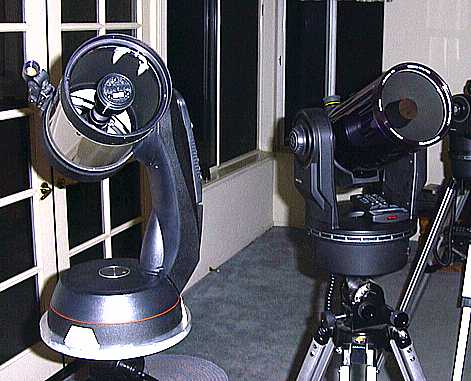MEADE ETX-125EC, CELESTRON NEXSTAR5 COMPARISON
Last updated: 13 October 1999
MEADE ETX-125EC, CELESTRON NEXSTAR5 COMPARISON |


ETX Family Portrait
ETX-125EC, ETX-90EC, ETX-70AT
On Friday, 1 October 1999, I had the opportunity to compare the Meade ETX-70AT, the ETX-90EC, and the ETX-125EC, and the Celestron NexStar5. Several senior people from Meade were there as well. We had been trying to set this up for weeks but various things like the weather and my Australia vacation kept us from making it happen. But it finally did. Meade was willing to do this because they recognize the value this ETX site provides to their customers. For that I thank both Meade and all the readers and contributors to this site.
With that said, some may read the following and believe there is a Meade bias in what I say. Everyone is entitled to their own opinion; I'll be expressing mine as to what I saw and experienced during the almost three hours we spent moving back and forth between the scopes. Since time was limited and I wanted to get as much experience as possible with the ETX-125EC and NexStar5, the ETX-90EC was only used for visual comparisons (since I already have experience with it) and I spent minimal time with the ETX-70AT. But I'll comment on everything that I can. And the last caveat is that this is not an indepth analysis or comparison of each telescope. There was simply not enough time to do that. But I hope this information will be of use nevertheless.


NexStar5, ETX-125EC
I moved the ETX-125EC, which was already mounted on the Meade Deluxe Field Tripod, outside; it was much heavier than the ETX-90EC on the Meade Deluxe Field Tripod. But it was still an instrument that could be moved and setup with a minimum of exertion. (I did not pickup the NexStar5; wish I had for comparison.) We set-up the telescopes, all on Meade tripods, and began the alignments. All the scopes were in Altazimuth mode. I initially chose to align the ETX-125EC but was prompted to try the NexStar5. This proved to be a challenge, for several reasons. One was my unfamiliarity with the controller. The next was that the standard red-dot finderscope was not aligned. Lastly, I found the drive motors inconsistent in movement. I would try to center a star but the drive would stop moving the scope in one direction for no apparent reason. I also found it somewhat clunky that there was no good way to manually move the NexStar5 in either RA or DEC (there are no tension locks). It will move manually in DEC but in jerks, not smoothly, and the RA will not move except by using the handcontroller. Of course, I was only doing this in an attempt to quickly find a bright star to align the finderscope. Deciding that this was not a worthwhile use of my time, one of the Meade people elected to align everything, allowing me to align the ETX-125EC.
All of us found aligning a challenge; all of the Easy Align selected stars were fainter than desirable. This was due to the date and time we were doing the alignments; there were just no really bright stars that the Autostar wanted to give us. In my case the Autostar (running 1.3) would give me a couple of good stars to choose from in the finder or 26mm eyepiece. Since we didn't have any star charts handy I kept skipping the Autostar selections in the hope of getting something better. Finally I decided that I might be OK; that is, only a little bit off in the alignment no matter which of the two stars in the finder or eyepiece that I centered. So I completed the alignment of the ETX-125EC and selected to GOTO M57, the Ring Nebula in Lyra. Much to my surprise and pleasure there was the beautiful "smoke ring" in the 26mm eyepiece!! It was bright, crisp, and large at 73X, much more so than in the ETX-90 with the same 26mm eyepiece (48X).
We then began looking at various objects. Stars were nice crisp points of light, with no noticeable focus shift. We also looked at Epsilon Lyrae (the Double Double) which Sky and Telescope reported as a problem with their ETX-125EC. S&T said that drive vibrations prevented them from seeing the secondary stars; the repaired ETX-125EC we were using had no such vibrations and the secondary stars were easily seen. M31 was a not just the smudge of faint fuzz you see in the ETX-90 but had a distinct shape in the -125. We even believe we could see a "dark lane" in the galaxy's structure. M32, its companion, was also visible. Impressive.
Then Jupiter appeared over the local mountains. Cloud bands were clearly evident even when using a 4.7mm eyepiece (404X). Our next treat was Saturn. We did some comparisons between the NexStar5 and the ETX-125EC using the same 4.7mm eyepiece. On the NexStar5 with its 1250mm focal length (same as the ETX-90) this eyepiece gave a magnification of 266X; on the ETX-125EC with its 1900mm focal length the 4.7mm eyepiece gave a magnification of 404X. In the ETX-125EC Saturn was magnificent. Bright, LARGE, and crisp, with Cassini's Division clearly visible (having a night with superb seeing helped a lot). We then viewed Saturn in the NexStar5 using the same 4.7mm eyepiece. The best description I can give is that it looked essentially the same as in the ETX-90 at this high (for the ETX-90) magnification. The image was slightly dimmer and definitely fuzzy; certainly not the same as in the Meade 5-inch. This comparison pointed out two factors that make the two telescopes different optically: the NexStar5 is a Schmidt-Cassegrain design with a much shorter focal length than the ETX-125 Maksutov-Cassegrain.
When using such large magnifications on both telescopes I felt that having an electric focuser would be beneficial. Neither the NexStar5 nor the ETX telescopes had one. In the ETX-125EC, induced vibrations dampened out quickly. They also dampened out quickly in the NexStar5 but I found the large focus knob under the eyepiece somewhat cumbersome to use due to its location. Being righthanded I would have preferred the knob to be on the right like on the ETX. Of course, this position is difficult for lefthanders to use so maybe the Celestron solution is more appropriate.
The handcontroller on the NexStar reminds me of a TV remote control but it was functional, even though I was used to the Autostar. I did find the slewing of the NexStar5 rather frustrating as I described earlier. But its tracking was reasonable. As we moved back and forth between viewing Saturn on the NexStar5 and the ETX-125EC, Saturn would drift only a small amount in the NexStar5 (to the edge of the 4.7mm field-of-view). But it almost always stayed centered in the ETX-125 with the Autostar. In fact, all the ETX telescopes using the Autostar performed amazingly well in tracking during the evening. As I moved back and forth from one ETX to another comparing views, the object centered would still be centered when I returned to the telescope. The less than perfect tracking on the NexStar5 could have been due to our lack of experience with it versus the Meade Autostar.
The ETX-70AT is a refractor attached to a slightly modified (taller) ETX fork mount and drive. Its focal length is 350mm, providing 17X with the supplied 20mm eyepiece. Objects viewed through the -70 were crisp although I did see some color dispersion when viewing Jupiter due to the nature of a refractor. Of course, objects were smaller in the -70 than in the other ETX telescopes. In fact, Saturn was rather disappointing. In a direct comparison of the ETX-70AT and the ETX-90EC, the -90 wins hands down. The ETX-90EC is a much more capable and versatile telescope than the ETX-70AT.
So, after spending some (albeit short) time with these telescopes, which would I buy? No doubt about it: the Meade ETX-125EC. It just felt better, performed better than the NexStar5, and provided much nicer viewing than the smaller model ETX telescopes. If the cost for the ETX-125EC is outside the budget, then the ETX-90EC remains the telescope of choice.
Meade has addressed the problems that surfaced when the initial ETX-125EC telescopes were delivered to customers. The revisions they have made seem to have corrected the problems. One fix they made bears repeating: they now include some extra packing material for the eyepiece end of the telescope. It is recommended that users keep this material and use it whenever packing the ETX-125EC in any case. This will prevent damage that could occur should the OTA receive a strong lateral jar.
I have posted a detailed specification comparison of the Celestron NexStar5 and the Meade ETX-125EC. This should answer many questions about the optics, controllers, GOTO databases, and more. Plus, I hope to be able to provide more indepth comments on the ETX-125EC at some point in the future.
Return to the top of this page.
Go back to the ETX Home Page.